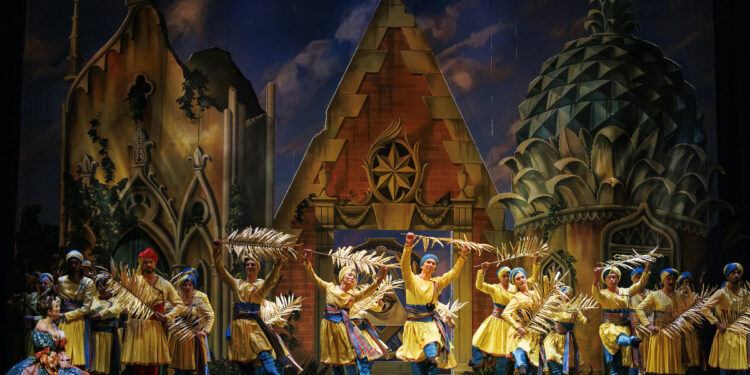(David Rabjohn has no educational background in the art of opera, so he will comment on the theatrical staging)
Opera Atelier’s stated objective is to create “complete artistic statements – with equal attention given to music, dancing, acting, and design.” This “completeness” is thoroughly achieved in their multi-layered production of Mozart’s ‘The Magic Flute.’
One of Mozart’s most popular achievements, the strength of this production is the very sum of its parts: Artists of the Atelier Ballet, Tafelmusik Baroque Orchestra, Nathaniel Dett Chorale, set design by Gerard Gauci. These combined elements create a strikingly rich experience.
Directed by co-artistic director Marshall Pynkoski and choreographed by co-artistic director Jeannette Lajeunesse Zingg, the opera tells the vibrant and comic story of the handsome Tamino (Colin Ainsworth), lost and pursued by a deadly beast. He is saved by three attendants of the Queen of the Night (Rainelle Krause) and then meets the earthly Papageno (Douglas Williams).
The Queen sends the pair on a mission to rescue her daughter, Pamina (Meghan Lindsay), who is trapped by her nemesis, Sarastro (Stephen Hegedus). Once at the palace, Tamino realizes new truths and understands the Queen’s evil deceptions. The titular magic flute and some special bells become their secret powers.
Krause makes her Atelier debut, described as a coloratura soprano, and she forcefully lives up to that designation. Her solo in Act Two is the most impressive as she hits notes like bright stars – the audience is unrestrained.
Ainsworth is equally talented as a tenor who becomes the hero rescuing both his love, Pamina, and his blustery mate, Papageno.
Act Two begins with Tamino and Papageno being tested by ordeals that lead to enlightenment. Confusion reigns as Pamina doesn’t understand the trials and believes Tamino to be unreliable. She is pursued by the evil (maybe more foolish) Monostatos (Blaise Rantoanina) played comically as a Yul Brenner style tough guy.
Enlightenment is achieved and all is joyful as Tamino and Pamina survive trials and even Papageno finally finds true love with Papagena (what a great name.)
The tone is often one of comic self-mockery – most suitable for Mozart’s delicious, mirthful opera. Tamino declares the monster to be dead in the wings of the stage. Several minor characters cavort like the Marx brothers. A cheeky scene with childish rope jumping is delightful. The sudden appearance and disappearance of zoo animals is equally fun.
Gauci’s set is spectacular and not just for the beautifully rendered backdrops. It is all achieved through simplicity – no reliance here on heavy digital technology. No lasers or holograms. No distracting video or creaky sound effects. It is a tribute to Mozart’s era. The energy here is devoted to Mozart’s vaulting music, the comic acting, and elegant singing.
Signature moments:
The entrance of Krause’s Queen of the Night was magical as she was elevated and softened by light scrims.
The placement of the chorus up in the stage left boxes was unique and resulted in a quiet power for their singing.
As mentioned, the zoo animals were a delight, partly due to the lack of high-end technology – they seemed to be moved by human operators, which added to the comedy.
There seemed to be moments of faux misogyny – groans emanated at some male vs. female comments, but all was meant in the light-hearted tone of the entire production.
Opera Atelier is observing 40 years of brilliant work. The choice of Mozart’s signature comic opera and the layering of the aforementioned creative artistic companies was a singular decision to celebrate that oeuvre of work.
‘The Magic Flute’ by W.A. Mozart
Performers: Rainelle Krause, Meghan Lindsay, Douglas Williams, Blaise Rantoanina, Colin Ainsworth, Stephan Hegedus, Karine White.
Artists of the Atelier Ballet
Tafelmusik Orchestra
Nathaniel Dett Chorale
Director: Marshall Pynkoski
Choreographer: Jeanette Lajeunesse Zingg
Set designer: Gerard Gauci
Runs through: October 19, 2025.
Tickets: ticketmaster.ca
















